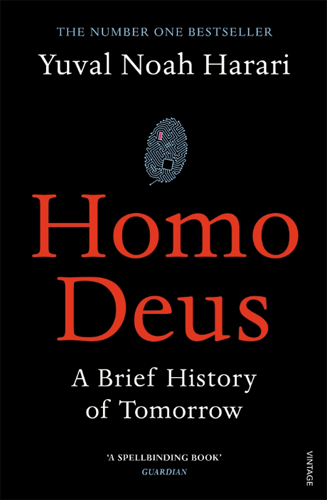A Big History of the Future: Homo Deus: A Brief History of Tomorrow
The central claim of Yuval Noah Harari’s Homo Deus is that we are on the cusp of an evolutionary transition in history that will eventually witness the creation of a new species of super humans, the man-gods of his title. Having created god in our own image, and then later having killed him, we humans are about to be overtaken in the evolutionary ladder of life by the very algorithmic process that produced us in the first place. As a result most humans will become a ‘useless class’ that will be dominated by non-conscious but highly intelligent algorithms that will, in Harari’s words, ‘know us better than we know ourselves’. Harari doesn’t speculate just how society will be remade by these algorithms, but he is fairly convinced that the wellbeing of humans will not be a priority in this brave new world. Humans will more than likely become the equivalent of the Neanderthals of humanity’s early history, or perhaps like contemporary domesticated animals. What will be of primary importance will be the free flow of data, a process that will not require humans at all.
Harari, who was trained as a medieval military historian, and holds a tenured position in the Department of History at the Hebrew University of Jerusalem, decided at some point to focus his attention on long-term history to avoid getting bogged down in the details that would distract him from what he believes is of real importance. In this regard, Harari’s general approach shares much with the genre of ‘Big History,’ as Harari situates his ‘history of tomorrow’ as he calls it, within a universal history that begins, as do all big histories, with the Big Bang and the origin of all life itself. Homo Deus is the sequel to an earlier book Harari wrote called Sapiens: A Brief History of Humankind (2014), which examined the history of humans as a species within the context of the history of the cosmos and then the development of life on earth. This is a story that clearly resonates with a wide readership: the book has been translated into over forty languages. Like other big histories, such as David Christian’s Maps of Time: An Introduction to Big History (2004), and his more recent Origin Story: A Big History of Everything (2018), along with Fred Spier’s Big History and the Future of Humanity (2011), and Cynthia Stokes Brown’s, Big History: From the Big Bang to the Present (2007), Harari focusses on what separates humans from other species: their intelligence, which through the development of language and writing, was passed on through both space and time. This is essentially what David Christian refers to as ‘collective learning,’ which Harari reframes around the notion of ‘flexible cooperation’, a flexible cooperation that has led to global domination.
Perhaps most relevantly, all big histories end with a discussion of the future, which their authors like to frame as a distinctive feature of the genre – in contrast to orthodox history writing, which is primarily concerned with what has actually happened. Taking a cosmic view of humanity from the perspective of 13.8 billion years apparently sheds light on long-term trends that extend beyond the present. And big histories typically worry about the unintended consequences of humanity’s global dominance, particularly anthropogenic climate change, which threatens to alter the earth’s climate in such a way as to bring about an end to the human species as well as other forms of life in the very near future. This catastrophe is always deemed avoidable, however, as the big history narrative is meant to provide readers with the insight to understand these long-term problems and develop the right strategies to alter the course of history. True to form, Harari’s Sapiens ends with a brief discussion of the future of the human species, a discussion that he then later extends into an entire book, which is, of course, Homo Deus.
Understandably, then, the book suffers from many of the problems that plague big histories in general, the most notable being that they aren’t really histories. It is true that there is a movement within the discipline of history to produce large-scale narratives that are not afraid to generalise in order to speak to wider readerships and possibly shape public policy, a movement that was articulated recently by Jo Guldi and David Armitage’s History Manifesto (2014). And big history was one of the examples promoted by Guldi and Armitage along with other large-scale approaches such as deep history and environmental history. What these forms of history apparently have going for them, aside from their macro approach, is their appropriation of the findings of modern science, which provide the evidentiary bases for their historical narratives. Sciences such as cosmology, geology, biology, climatology, and evolutionary psychology are corralled to provide the facts for the large-scale historical narratives that largely reject written records as hopelessly biased sources that could anyway only give us access to the last few thousand years of specifically human history, a mere moment in the grand scheme of things.
But the kinds of narratives that are produced by these genres perhaps understandably read an awful lot like the narratives of popular science from which they are borrowed. Thus in big history we learn not about people but about processes, about ‘Goldilocks circumstances’ and ‘threshold moments,’ about ‘energy flows’ and ‘increasing complexity.’ These supposedly scientific concepts end up doing a lot of work but rarely are they subject to the kind of scrutiny that typifies historical inquiry. Instead they are simply accepted as well-established ahistorical facts that add legitimacy to their historical narratives.
Whereas most big histories, such as Spier’s Big History and the Future of Humanity, rely on theories developed from physics to structure their narratives, Harari relies on theories developed from the biological sciences. This is entirely understandable for a study that is essentially about the past and future of the human species. Sapiens and Homo Deus are in this sense evolutionary narratives. Harari is quite explicit about this. But what he fails to communicate to the reader, or perhaps fails to realise himself, is that his evolutionary narratives derive meaning not from biology itself, but from his interpretation of biological findings, some of which are highly contentious.
For a start, he embraces a general view of evolution that was promoted by the paleontologist and populariser of science Stephen Jay Gould: that evolution is an entirely contingent process such that the arrival of humans was the unforeseen result of an incredible sequence of events, shaped by millions of years of natural selection. This has several implications for Harari, the main one being that the discovery of evolution by Darwin led to the death of God, and along with it the death of the soul, thereby forcing humans to find meaning not in some grand cosmic purpose but rather in themselves, leading to the establishment of a humanist ideology based on a general belief in free will and individuality. That is a lot of meaning that Harari is able to discern from what is actually a fairly contentious view of evolution that, for instance, takes no account of what Simon Conway Morris in Life’s Solution (2003) stressed about the ubiquity of evolutionary convergence (i.e., the fact that similar forms of life seem to arise via different evolutionary pathways). Just how competing views of evolution like Conway Morris’s might challenge Harari’s larger interpretation are not explored.
Undeterred by such scientific complications, Harari ads a further interpretive layer to his evolutionary narrative, an interpretation that is most closely associated with the work of the philosopher Daniel Dennett, which argues that the evolution of life is best understood as an algorithmic process, that Darwin’s theory of natural selection refers to a set of simple procedures that nature follows that tend to yield results that favour those best adapted to their environment. In explaining how evolution functions like an algorithm, Harari argues that algorithms are essentially recipes or sets of instructions that are typically associated with the functioning of machines. In the case of a vending machine, for instance, Harari explains that when a man walks up and presses a button, the machine kicks into action by following a precise set of steps to fulfill the command. ‘It drops a tea bag into a cup, pours boiling water, adds a spoonful of sugar and milk, and ding! A nice cup of tea emerges. This is an algorithm.’ Harari goes one step further again, however, by arguing that the ‘man pressing the buttons and drinking the tea is also an algorithm.’ In other words, it is not just the evolutionary process that is an algorithm: ‘organisms themselves are algorithms’. This is quite an interpretive leap, and it is one that is absolutely central to the main claim of Homo Deus: that algorithms, not unlike those that underpin Google’s search engine or direct Facebook ads to particular users, will become the new man-gods through the mastery of big data, aided by the development of the religion of ‘dataism,’ which will displace the humanist religion that was dominant during the last age of man. Harari does not cite Dennett in his discussion of evolutionary algorithms, or anyone else for that matter. ‘It is the life sciences,’ Harari claims, ‘that concluded that organisms are algorithms’. Well, actually, as far as I can tell, only Harari has ever made that claim. But here and throughout the book Harari hides his own interpretations of the meaning of scientific theories and experiments behind phrases like ‘according to the life sciences…’ or ‘the life sciences challenge…’ as if the life sciences speak with one unified voice about highly speculative theories, some of which only seem to originate in Harari’s own fantastic imagination.
To say that there is a failure here to appreciate the complexities of science and its historical development is a bit of an understatement. And this problem is compounded whenever Harari discusses the historical relationship of science and religion. Here we get the old story of scientific development leading to an increase in secularisation. Evidence against this thesis, such as the relatively recent increase in religious believers throughout the world, is simply batted away as irrelevant when the real advances in society are deemed to be provided by medical breakthroughs, scientific discoveries, and corporate inventions. When was the last time, Harari asks, that the Bible was a true source of inspiration leading to some sort of advancement, technological or otherwise (321–2)? Certainly not in the last few hundred years. Case closed.
Where I do have some sympathy for Harari’s project, however, is in its subtle deviation from the typical compensatory futurism of the big history narrative. While Harari does embrace the stereotypical story of secularisation that is central to big history, he does not seek to provide a new metanarrative to take the place of the creation stories of religion that are apparently falsified by modern science. Of course, this is one of the main purposes of big history, namely to provide a universal story based on science that will help to unify humanity, which has apparently suffered a profound existential fragmentation due to the decline of established religious worldviews. Harari unapologetically argues that while that desire is central to a humanist religion that emerged during an age of the death of God, it will no longer be relevant in an age of the death of man. And herein lies the biggest distinction between Harari’s and other big history approaches. Whereas big histories typically seek to tell a story that will help to preserve the human species long into the future by, for instance, providing the intellectual tools to overcome anthropogenic climate change, Harari is much less interested in attempting to preserve humanity in the face of the dystopian future that he outlines. At one point he does suggest that perhaps these algorithmic processes could be slowed down, or that if the reader is concerned about this future she ‘is welcome to think and behave in new ways that will prevent these particular possibilities from materializing’. But even this half-hearted suggestion contradicts Harari’s more typical ambiguous tone, which neither welcomes nor laments the coming of our algorithmic overlords. Some might find Harari’s general apathy to the future that he outlines troubling because it is so clearly horrific. But it is only horrific from an anthropocentric position; and given the treatment humans have perpetuated on non-human animals in the modern era, a treatment that Harari outlines at the beginning of Homo Deus, I found his shoulder-shrugs about the inevitable end of humanity as we know it at the hands of algorithms rather refreshing.
Moreover, in light of recent events such as the 2016 US election, and the recent revelations about Cambridge Analytica’s harvesting of Facebook users’ data to influence voting intentions, Harari’s future speculations about the increasing power of AI and algorithms seem less speculative by the day. As Harari himself points out, legislative bodies are so far behind understanding how the algorithms at the heart of companies like Google and Facebook work, that they are incapable of properly legislating them. This became profoundly obvious during Mark Zuckerberg’s recent day of testifying in front of the US Senate Committee in April 2018, which included questions from septuagenarian senators who clearly had little understanding about how Facebook actually worked. The second day of questioning was a little better, as it was in front of the House of Representatives, which is a generally less ancient group of politicians, and Zuckerberg was forced to respond to questions about why certain ads continued to remain on the site despite the fact that they clearly contravene federal laws. Zuckerberg’s response was telling: Facebook was at the mercy of AI tools that hadn’t developed quite quickly enough to keep up with the daily advertisements that were posted on Facebook. In other words, there was nothing he could do about it. In this context, I think most readers will find the last hundred pages of Harari’s book quite insightful. I just don’t see what is gained, however, in situating this near future within a half-baked evolutionary history that confuses the process of evolution with its result.







